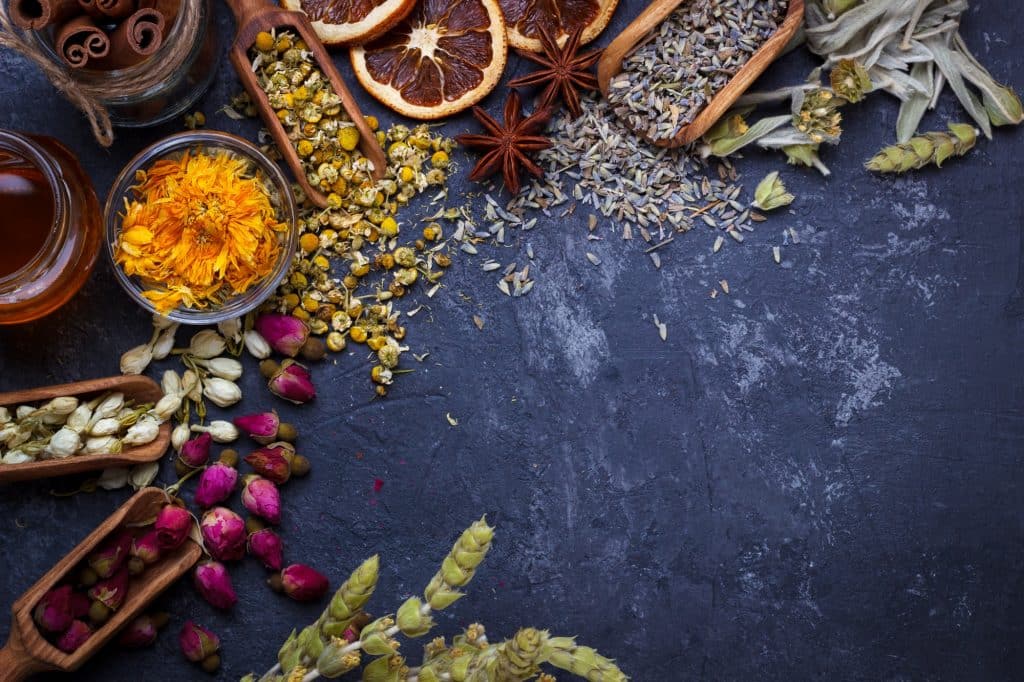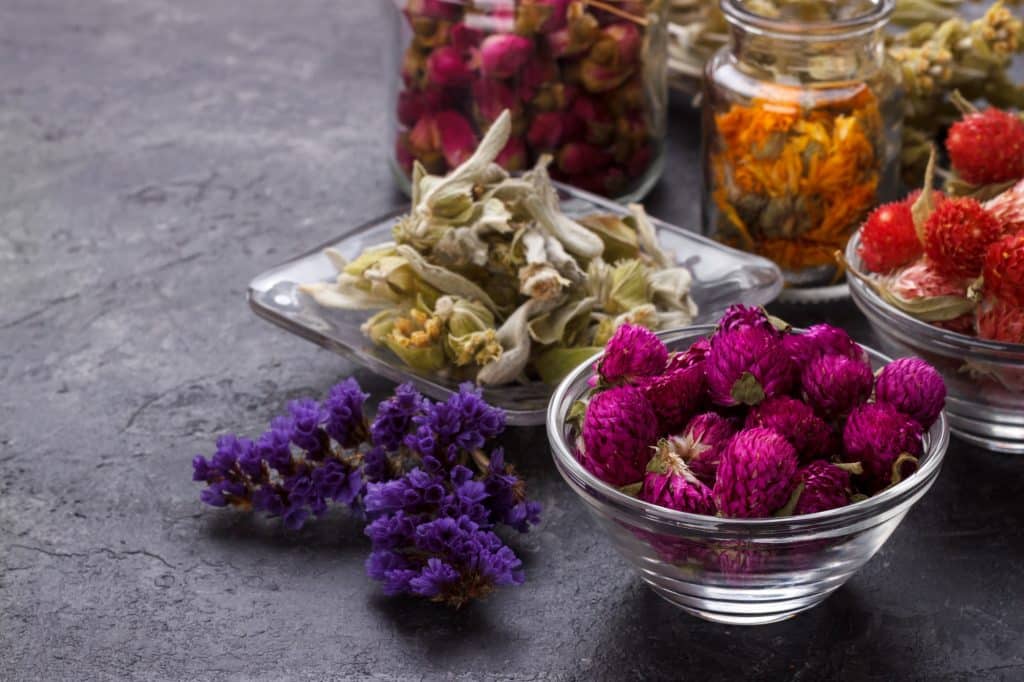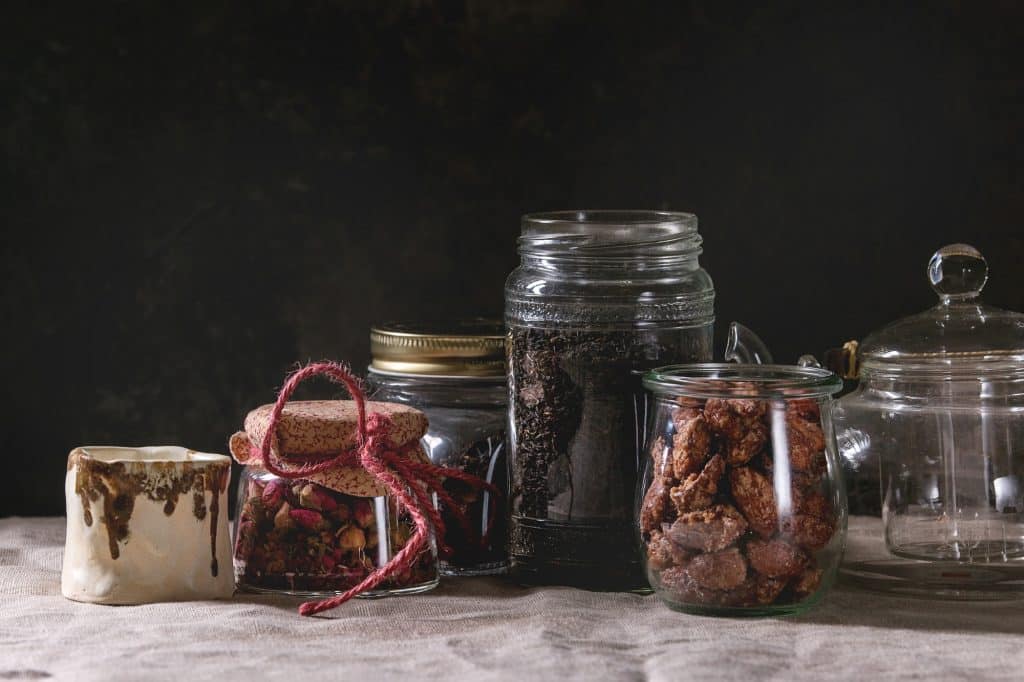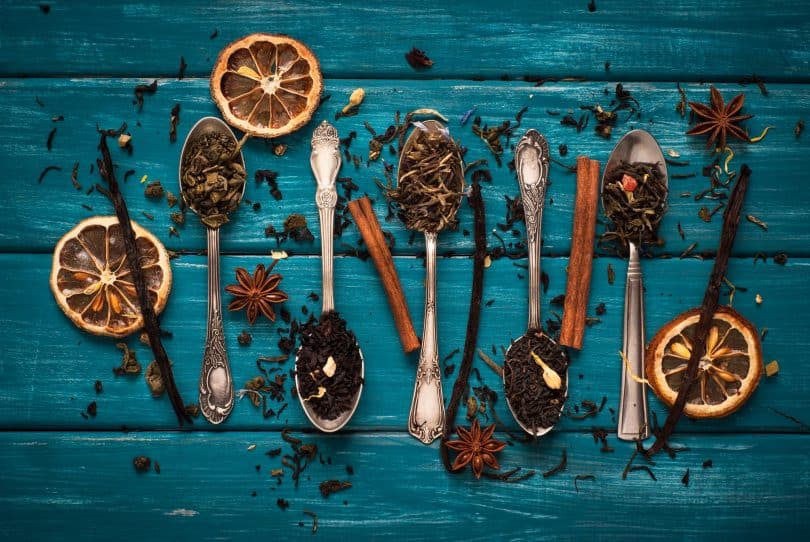If you’ve ever had a tea that you absolutely loved, but it could use just one more thing, this post is for you! Learn to make your own tea blends so you can have your favorite cup of tea on hand without having to worry about it going out of stock.
It’s relatively easy to make your own tea blends but it can be difficult to get just the right flavor. For this reason, I recommend starting with very small batches, just enough for a couple of pots of tea to try out and see how you like the flavor.

What’s in a Blend: How to Make Your Own Tea Blends
Each blend starts with a base—black, oolong, green, white, rooibos, or herbal—with a secondary flavor to give it a little depth. You can add all kinds of things to tea to make your own unique blends, which we’ll talk about towards the end of this post.
Choose a Base
The most common bases used in teas are black, oolong, green, or some sort of herbal base. You’ll occasionally see white tea or even fermented tea like pu’erh, but these are far less common. For your first blend, we’ll go with something a little more common and easy to work with.
We’ll talk about different kinds of tea and some different flavors you can try out. Remember—they’re just recommendations! Just because you don’t see a certain flavor combination doesn’t mean it won’t work. You’re also not limited to using just one tea as a base—many tea blends use a couple of different varieties.
Black Tea
For breakfast teas, you’ll want the bold, full flavors of Ceylon or something strong and malty like Assam. Both make excellent bases for breakfast teas and can even be blended together for a nice flavor. (One of my favorite breakfast blends does half and half.)
Other black tea blends depend on what other flavors you want to add. You’ll find that tea leaves can carry a full range of flavors on their own, so it’s important to research what regions the tea comes from and what’s typical of those leaves. You’ll find flavors of all kinds—floral, fruity, spicy, and even smoky, depending on how the tea leaves are processed. Here are a few to look for:
- Ceylon: Bold, rich, sometimes with a hint of spice
- Assam: Rich and malty
- Yunnan: Dark, malty, chocolatey, with a lingering sweetness (referred to as red tea because of the liquor color, not to be confused with rooibos)
- Keemun: Smooth, malty, fruity, floral, a little toasty
- Nilgiri: Very fragrant, floral, and subtly sweet
- Lapsang Souchong: Bold, rich, smoky, and a little sweet
Oolong Tea
Oolong has many different varieties and probably has the widest range of flavors. They’re oxidized for varying amounts of time, so they’re somewhat between a black and a green tea and can have characteristics more like one or the other depending on how they’re processed.
My favorites are oolongs that are a little closer to green tea, particularly ones that are sweet and floral, almost a little grassy. These go well with floral flavors like lavender and rose and citrus flavors like lemon and orange. Here are a few varieties to start with:
- Jin Xuan: Creamy, smooth, lightly floral
- Wuyi Oolong: Toasty, nutty, earthy, floral
- Li Shan: Smooth, fruity, floral, vegetal, a little buttery
- Ali Shan: Creamy, floral, with a lingering sweet aftertaste
Green Tea
Green tea is one of those that people either love or hate, mostly because of the slightly grassy or vegetal flavors. They’re among my personal favorites, but they’re not for everyone! I’ve included some of my favorite varieties to start out with:
- Sencha: Sweet, vegetal, grassy
- Gyokuro: Full-bodied, rich, minerally, savory aftertaste
- Genmaicha: Grassy, nutty, toasty, savory
- Biluochun: Full, sweet, floral, and fruity
- Gunpowder: Bold, grassy, lightly smoky
- Dragonwell: Rich, smooth, vegetal, a little toasty and sweet
Herbal Tea
If you’re going with an herbal blend, choose an herb with a distinct flavor that can really tie everything together. Peppermint and chamomile are commonly used as a base, often accompanied by floral or fruit flavors. If you’re going herbal because you want to avoid caffeine, you can also use red tea (rooibos) as a base as well. Some of my favorites to use as a base include these (either by themselves or in a mixture):
- Peppermint
- Spearmint
- Lemon Balm
- Lemon Verbena
- Chamomile
- Raspberry Leaf

Pick a Secondary Flavor
While you can make a wonderful blend out of tea leaves alone, you’ll find that most tea blends add in a variety of herbs and oils to add even more flavor to a blend. Earl Grey tea leaves are infused with bergamot oil, and you’ll often find orange rinds, lavender, and sometimes rose added to it.
Most commonly, you’ll find herbs and flowers added to your tea blends. Here are some common ones to try out:
- Lavender
- Rose petals/rose hips
- Mint (peppermint, spearmint, and chocolate mint are common)
- Anise hyssop
- Lemongrass
- Hibiscus
- Rosemary
- Sage
- Pine needles
- Stevia leaf
- Sweet basil
- Fennel
- Jasmine
There are many, many others and it all just kind of depends on your preferences.
Other Additions
You’ll find many other additions in your tea blends—spices, nuts, dried fruit, and sometimes even things like mint candy, milk chocolate, rock sugar, and cocoa nibs (especially around the holidays). While chocolate in tea has gained a lot of popularity, if you prefer your tea blends without sugary treats, cocoa nibs can add a nice flavor to tea without making it sweet.
Here are some extras to consider including in your tea:
- Crushed hazelnut or almonds
- Cocoa nibs
- Dried fruit (strawberries, apples, raspberries, and peaches are common in flavored teas)
- Orange rinds or dried, thin slices of orange
- Spices like cinnamon, nutmeg, allspice, ginger, cloves, star anise, and pepper
- Crushed peppermint candy
- Rock sugar
Example Blends
If you just want to know how to make your own tea blends but didn’t have a particular blend in mind, I’ve included a few below to get started with.
Orange Breakfast Blend
- 4 tablespoons black tea
- ½ teaspoon chopped ginger, dried (You can get freeze-dried ginger slices and chop them up into smaller pieces)
- ⅛ teaspoon cinnamon
- Dried orange slices or orange rind
Floral Oolong
- 4 tablespoons Wuyi oolong
- 1 teaspoon rose petals
- 1 teaspoon chamomile
- ½ teaspoon lavender
Spiced Green with Cocoa
- 4 tablespoons gunpowder green
- 1 tablespoon cocoa nibs
- Cinnamon, cloves, cardamom, ginger, and star anise to taste

Storing Your Tea
Once you find a blend you like, just scale it up and make a larger amount to keep on hand. Storing it in an airtight container or bag is important, as exposure can drastically affect the flavor, especially in green teas.
Here are some recommendations on storage containers for your blends.
If you liked our guide on how to make your own tea blends, check out some of our related posts. Grow your own herbs for tea with our gardening guide or try a cold brew tea!
































